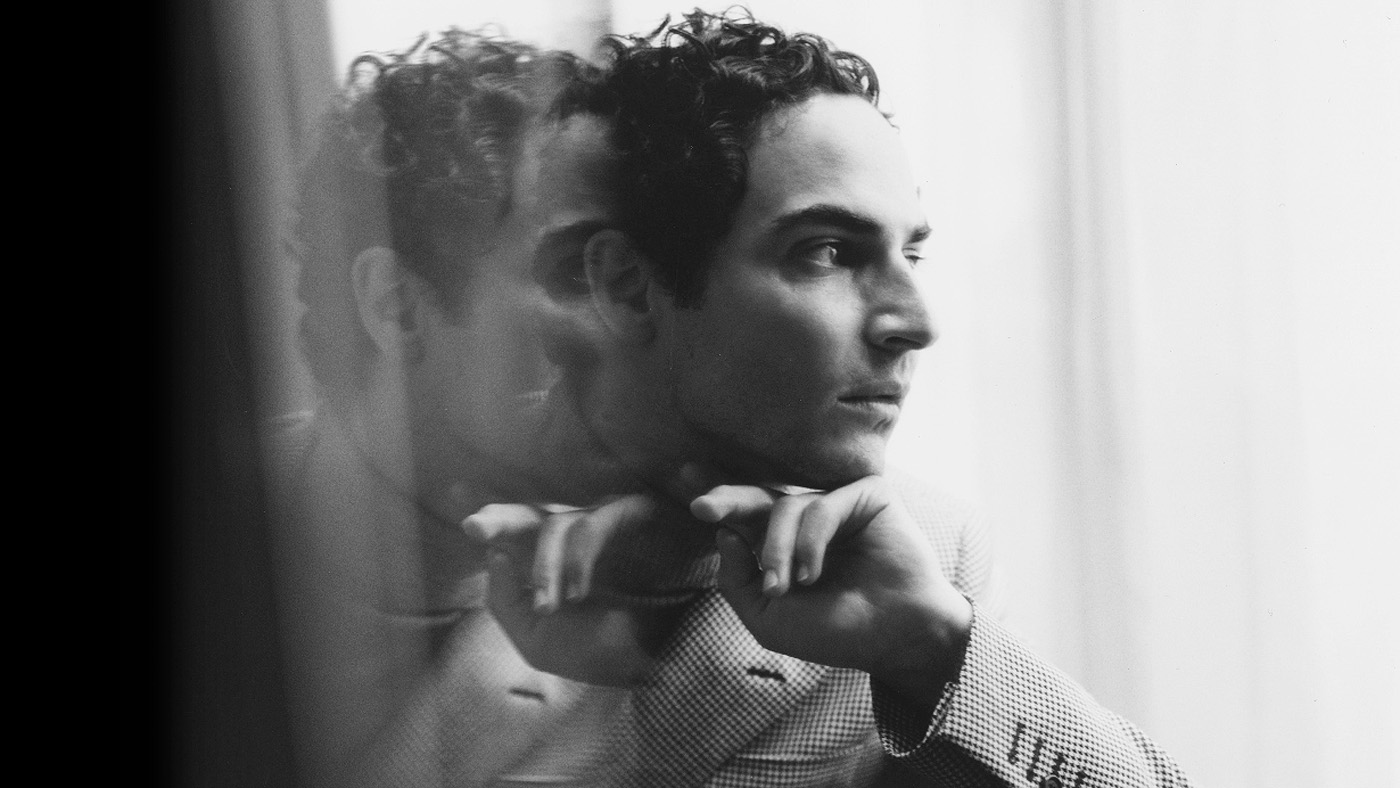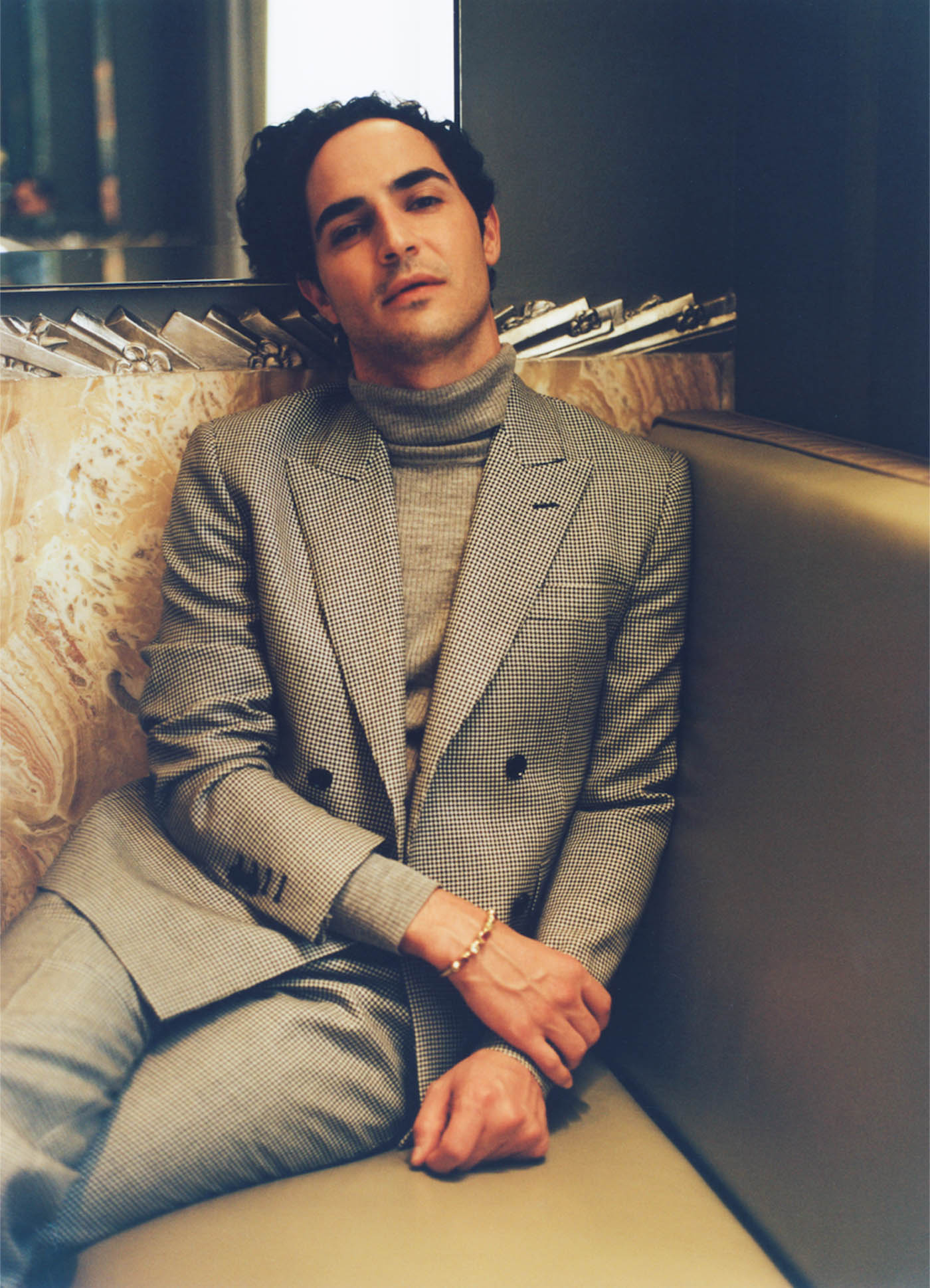How Zac Posen is bringing womenswear to America's oldest clothier
The king of red-carpet dressing is creating a new repertoire of classic femininity for Brooks Brothers

"I really think there is an importance to dress," says Zac Posen, reclining on a champagne-coloured velvet banquette at Claridge's Fumoir Bar in London. It's an early Wednesday morning and guests are breakfasting in the bright foyer of the hotel. Preferring a calmer atmosphere, the Manhattan-born designer looks every bit the debonair gentleman in the dimly lit, Art Deco cocktail bar. "We wear costume in everyday life; it's how you present yourself to the world," he continues. "It can give you strength and confidence."
If all the world's a stage, Posen today resembles a modern-day Fred Astaire by way of downtown New York: he is wearing a Brooks Brothers black-and-white woollen houndstooth suit with a silk roll-neck sweater tucked neatly into high-waisted trousers. "I normally wear a shirt and tie, but I wanted to be comfortable," he says. Posen has a well-documented penchant for tailored suits; this morning's choice is one of 40 the designer adds to his wardrobe every year.
Gentlemen's suits such as the made-to-measure number Posen is sporting today have been Brooks Brothers' raison d'etre since its founding in 1818. The US's oldest clothier, it is best known in modern times as the custodian of all-American preppy style. Its client list includes the US's political elite – 39 of the 44 presidents to date, from Abraham Lincoln to Barack Obama, have been outfitted by Brooks Brothers. Historically, the brand has been a pioneer in menswear; it introduced the ready-to-wear suit to the States in 1849, followed by Harris Tweed in 1900.
The Week
Escape your echo chamber. Get the facts behind the news, plus analysis from multiple perspectives.

Sign up for The Week's Free Newsletters
From our morning news briefing to a weekly Good News Newsletter, get the best of The Week delivered directly to your inbox.
From our morning news briefing to a weekly Good News Newsletter, get the best of The Week delivered directly to your inbox.
Brooks Brothers began selling womenswear as early as 1874, but it took a further century for the retailer to unveil its first comprehensive women's department at its New York flagship store in 1976. Classic designs for the female customer proved lucrative, but womenswear never muscled up to the commercial brawn of the menswear; it needed to step out of the shadow of such a strong patriarchal legacy.
To many, the appointment in 2014 of Zac Posen as creative director of womenswear and accessories came as a surprise. The bon vivant designer, revered for his exquisitely crafted and draped garments, is responsible for some unforgettable red-carpet moments; for this year's Met Gala in May, he dressed actor Claire Danes in a sweeping ballgown lit up with hundreds of tiny lights.
Posen's own clothing line is the epitome of high glamour as dreamed up in the designer's couture atelier, while Brooks Brothers largely stands for sophisticated classics. For this reason, the perceived polarity between man and brand was always going to raise eyebrows. However, defining his role as a custodianship, Posen has crystallised the idea of the contemporary Brooks Brothers woman within the context of the house's storied aesthetic. So far, his approach has been soft and considered. "It's not about ego with Brooks Brothers," he says. "For me, it was not a revolution; it was about an evolution. The same attitude, but with a new fit and owning signature elements that Brooks Brothers originated."

Posen's first collection, for SS16, which also marked Brooks Brothers' debut at New York Fashion Week in September 2015, imagined a New England holiday wardrobe in vibrant prints courtesy of graphic artist Pierre-Marie Agin, who previously collaborated with luxury brands such as Hermes and Sonia Rykiel. Printed silk shirt dresses and checked palazzo trousers were paired with bucket hats and tote bags as Posen focused on casual luxury as worn by sun-seekers vacationing on Nantucket island.
A free daily email with the biggest news stories of the day – and the best features from TheWeek.com
Back in New York, Posen's schedule is unremitting: he creates 16 collections a year, for both Brooks Brothers and his eponymous ready-to-wear, diffusion and bridal lines. He also appears as a judge on hit US show Project Runway and is currently penning his first cookbook. Despite the heavy workload, the Manhattan-born designer seems remarkably serene – a reaction, he says, to so many years living life in the fast lane, having launched his own label at the tender age of 20. "As you grow, you find new levels of perspective. That's the beauty of ageing in an industry that is so youth-obsessed. There is something wonderful about maturity," he says, aged just 35. Sat in the Fumoir, he looks poised to take on the world; commandeering the womenswear division of a brand historically favoured by US presidents isn't a bad start.
Henry Sands Brooks opened his first store on Manhattan's Lower East Side in 1818, with a view to selling high-quality garments to a discerning clientele at a fair price. He began outfitting the military and subsequently extended his tailoring services to higher-ranking officers and commanders; presidential patrons soon came calling. In 1850, a year after Brooks introduced the ready-to-wear suit, his four sons inherited the company and changed its name to the present one. Abraham Lincoln donned a bespoke Brooks Brothers overcoat ror his second inauguration, in 1865, the lining embroidered with the words: "One Country, One Destiny" beneath the symbol of an eagle; in a sad twist of fate, Lincoln was wearing this same black coat when he was assassinated two weeks later. And John F Kennedy wore a Brooks Brothers suit when he married Jacqueline Bouvier in 1953; his groomsmen left the party clutching the brand's umbrellas as gifts.
By then, Brooks Brothers was firmly established in the American lexicon as a brand synonymous with quintessential preppy style – a look first popularised on the campuses of elite Ivy League colleges. Two decades later, the genteel style would endear Brooks Brothers to the upwardly mobile: the wolves of Wall Street and the suited-and-booted power-dressers of the 1980s. The firm changed hands several times over the ensuing decades – including a takeover by Marks & Spencer in 1988 – before it was sold in 2001 to a company that became the Brooks Brothers Group, operated by Italian businessman Claudio del Vecchio, whose directive it was to modernise the brand as a beacon of US style.
For Posen, "owning signature elements that Brooks Brothers originated" is key to this global strategy. These elements include the iconic white shirt with button-down collar and the blue blazer once favoured by Andy Warhol, habitue of downtown Manhattan and a lifetime Brooks Brothers client.
Born in 1980, Posen had an upbringing that was coloured by his parents' profession as artists working and living in Warhol's former stomping ground. He and his sister Alexandra, grew up in a SoHo loft apartment that doubled as an art studio. "I was able to experience a kind of aesthetic and a lifestyle that very few people grew up with. It was an artists' community," he says of the area, which, with its converted factories, was still a haven for avant-garde artists in search of low rents and light-flooded spaces. "Today, it is a coral reef of what it started as," he adds. Posen's artist father Stephen instilled in him a love of craft as well as a strong sense of dedication. "How to express yourself through your imagination and your hands was something that was just always in my household," Posen says. Despite growing up in the MTV-obsessed 1990s, the designer's childhood was blissfully bohemian; his playtime was considered an opportunity for enterprising creativity.
From an early age, Posen and his sister were encouraged to make things; he relates how they would walk the family's beloved poodle through the then-industrial neighbourhood of SoHo and forage for fabric remnants from local manufacturers, which he would later fashion into dolls' clothes. "What was put on the street were my play tools and that was fabric," he says, beofre lamenting the decline of artisanal production: "People creating careers by making things with their hands is not what is valued anymore." As such, Posen cherishes Brooks Brothers' production standards. "It's not fast fashion," he says. "There is fabrication within Brooks Brothers that nobody can use on a collection level."
The question remains as to how the young designer managed to assimilate the weighty legacy of such an iconic brand. How does one go about unravelling 200 years of history – or even half a decade, for that matter? Posen began by studying the very fabric of Brooks Brothers, literally unpicking some of the brand's best-loved designs to discover their secrets. "When I got there, the first thing I did was to tear up jackets to understand what was in the breastplate, in the shoulder, the balance. Real basics."
Posen's creations for Brooks Brothers are produced to be worn by an expansive customer base: 16 collections comprising 70 styles each, sold in almost 300 stores worldwide and online. "We are an international brand so when we create a collection, we have to imagine it being sold globally, all at the same time," he says. The company is a vertical retailer, meaning it holds full control over its products by carrying out all stages of production and distribution in-house. "You can't design in a hole; your responsibility is building business," Posen says.
The designer is acutely aware of the importance of commercial viability, having experienced the highs and lows of running his own label for 15 years. Aged 18, Posen left New York for London to study fashion design at Central Saint Martins. It was 1998, a seminal time in British fashion led by Alexander McQueen and John Galliano, who were shaking up Parisian fashion houses Givenchy and Christian Dior. "It was a moment of real deep fantasy and imagination," says Posen, "and that was really impactful for me."
Inspired by the audacity of these fellow alumni, he began to explore his signature style with creations that were unapologetically feminine, even though, Posen says, "the school itself was moving towards the idea of putting out very conceptual designers at that time. Anything romantic, anything feminine was like the kiss of death for them." His stubbornness served him well, though; Posen has made a career out of feminine designs that stand the test of time, be they for a Hollywood clientele or for a national institution such as Brooks Brothers. "Trends are really boring – it's an old model," he says.
His AW16 collection for the American brand is flattering and wearable, with a nod to Old World chic and romance. Posen imagined "the eccentricity of how certain people dress with age" as adopted by a fashion-conscious shopper. The new Brooks Brothers woman steps out in masculine tailoring in the form of velvet slacks, belted greatcoats and evening tuxedos – a first for the label. Silk blouses feature mandarin collars and skirts are fastened in a bow over cashmere sweaters. There are dresses with geometric prints and heritage checks, while silk pyjama suits recall the glamour of 1930s movie starlets. "My dad introduced me to every old film at probably way too young an age," he says of classic cinema, which has proved to be an enduring influence.
While he currently directs and edits the work of four creative teams working across Brooks Brothers and his own lines, Posen treasures the hands-on aspects of his role. "I feel very fortunate that I can still go into my office and drape a significant amount of pieces," he says. It's this dedication to hard work interlaced with playfulness that most aligns him with Henry Sands Brooks, whose empire has dressed generations of Americans. "Patience is a virtue. I always think what I am building is for my grandchildren," says Posen as he leaves, ready for his close-up, looking like the most dashing of matinee idols.
Photography by Thurstan Redding
-
 The Week Unwrapped: What’s the cost of PFAs?
The Week Unwrapped: What’s the cost of PFAs?Podcast Plus why is George Osborne joining OpenAI? And has universal basic income finally come of age?
-
 The week’s best photos
The week’s best photosIn Pictures A dervish dance off, a frosty forest, and more
-
 Mount Rainier is on its way down
Mount Rainier is on its way downUnder the radar Its peak elevation is approximately 20 feet lower than it once was